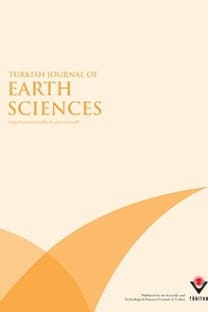Grey water footprint assessment of geothermal water resources in the southeastern Anatolia region
Grey water footprint assessment of geothermal water resources in the southeastern Anatolia region
___
- Aldaya MM, Rodriguez CI, Fernandez-Poulussen A, Merchan D, Beriain MJ et al. (2020). Grey water footprint as an indicator for diffuse nitrogen pollution: the case of Navarra, Spain. Science of the Total Environment 698: 134338. doi: 10.1016/j. scitotenv.2019.134338
- American Public Health Association (APHA). American Water Works Association, (1995). Standard methods for the examination of water and wastewater, USA.
- Baba A, Şaroğlu F, Akkuş I, Özel N, Yeşilnacar Mİ et al. (2019). Geological and hydrogeochemical properties of geothermal systems in the southeastern region of Turkey. Geothermics 78: 255-271. doi: 10.1016/j.geothermics.2018.12.010
- Derin P (2019). Investigation of Karaali (Sanliurfa) geothermal field in terms of heavy metal pollution, MSc, Harran University, Sanliurfa, Turkey. (in Turkish)
- Ernst FB, Yesilnacar Mİ, Sak, ZH, Atasoy AD, Ciftci C et al. (2021). An administrative model suggestion for the management of geothermal energy resources in Şanlıurfa, Turkey. Dicle University Journal of Engineering 12 (2): 451-457. doi: 10.24012/dumf.871675
- Chapman D (1996). Water Quality Assessments-A Guide to Use of Biota, Sediments and Water in Environmental Monitoring. 2nd ed. CRC Press, Boca Raton, FL, USA.
- Derin P, Yetiş AD, Yeşilnacar Mİ, Yapıcıoğlu P (2020). Investigation of potential heavy metal pollution caused by geothermal waters in GAP’s largest irrigation area. Geological Bulletin of Turkey 63 (1): 125-136. doi: 10.25288/tjb.626743
- Franke NA, Bovaciuglu H, Hoekstra AY (2013). Grey Water Footprint Accounting: Tier 1 Supporting Guidelines - Value of Water Research Report Series No 65. UNESCO-IHE, Delft, The Netherlands.
- Southeastern Anatolia Project (GAP) Regional Development Administration (2015). GAP İleri Jeotermal Kaynakları Araştırma Projesi Raporu, Türkiye.
- Hoekstra AY, Chapagain AK, Aldaya MM, Mekonnen MM (2011). ‘The Water Footprint Assessment Manual’, Earthscan, LondonWashington, DC.
- Kroese, DP, Breroton T, Taimre T, Botev ZI (2014). Why the Monte Carlo method is so important today. WIREs Computational Statistics 6 (6): 386–392. doi: 10.1002/wics.1314
- Miglietta PP, Toma P, Fanizzi FP, De Donno A, Coluccia B et al. (2017). A grey water footprint assessment of groundwater chemical pollution: case study in Salento (southern Italy). Sustainability 9 (5): 799. doi: 10.3390/su9050799
- Morera S, Corominas L, Poch M, Aldaya MM, Comas J (2016). Water footprint assessment in wastewater treatment plants. Journal of Cleaner Production 112: 4741–4748. doi: 10.1016/j. jclepro.2015.05.102
- Qambrani NA, Rahman MM, Won S (2017). Biochar properties and eco-friendly applications for climate change mitigation, waste management, and wastewater treatment: A review. Renewable and Sustainable Energy Reviews 79: 255–273. doi: 10.1016/j. rser.2017.05.057
- Serio F, Miglietta PP, Lamastra L, Ficocelli, S, Intini F et al. (2018). Groundwater nitrate contamination and agricultural land use: A grey water footprint perspective in Southern Apulia Region (Italy). Science of the Total Environment 645: 1425-1431. doi: 10.1016/j.scitotenv.2018.07.241
- Water Footprint Network (WFN) (2014). Water Resources Management, WFN Manuel.
- World Health Organization (WHO) (2011). WHO Guidelines for Drinking-water Quality, 2011.
- Yapıcıoğlu P (2019a). Grey water footprint of a dairy industry wastewater treatment plant: a comparative study. Water Practice and Technology 14 (1): 137-144. doi: 10.2166/wpt.2018.114
- Yapıcıoğlu P (2019b). Seasonal water footprint assessment for a paint industry wastewater treatment plant. Sakarya University Journal of Science 23 (2): 175-183. doi: 10.16984/ saufenbilder.411137
- Yapıcıoğlu, P (2020). Grey water footprint assessment for a dye industry wastewater treatment plant using Monte Carlo simulation: Influence of reuse on minimisation of the GWF. International Journal of Global Warming 21 (2): 199-213. doi: 10.1504/IJGW.2020.10030266
- ISSN: 1300-0985
- Yayın Aralığı: 6
- Yayıncı: TÜBİTAK
Hasan Hüseyin ÖZTÜRK, Barış ÇARIKCI, Merve SEFA, Kevser MERMER AKMAZ, Ayşe ÜSTÜNOLDU KANDEMIR, Feza ŞEN
Toygar AKAR, Ünsal GEMİCİ, Melis SOMAY-ALTAŞ, Gültekin TARCAN
Ranjith Pathegama GAMAGE, Badulla Liyanage AVANTHI ISAKA
Bülent Oktay AKKOYUNLU, Mete TAYANÇ, Elif BALKAN-PAZVANTOĞLU, Kamil ERKAN, Müjgan ŞALK
Grey water footprint assessment of geothermal water resources in the southeastern Anatolia region
Mehmet İrfan YEŞİLNACAR, Pelin YAPICIOĞLU
Dorothee SIEFERT, Markus WOLFGRAMM, Thomas KÖLBEL, Johannes GLODNY, Jochen KOLB, Elisabeth EICHE
Alper BABA, Mehmet Kamil MERİÇ, Yasemin Senem KUKUL, Emrah ÖZÇAKAL, Yakubu Abdullahi JARMA, Nalan KABAY, Neriman Tuba BARLAS, Hakan ÇAKICI
Muhammed Fatih CAN, Can BAŞARAN, Ahmet YILDIZ, Müfit DEMİRKAPI
